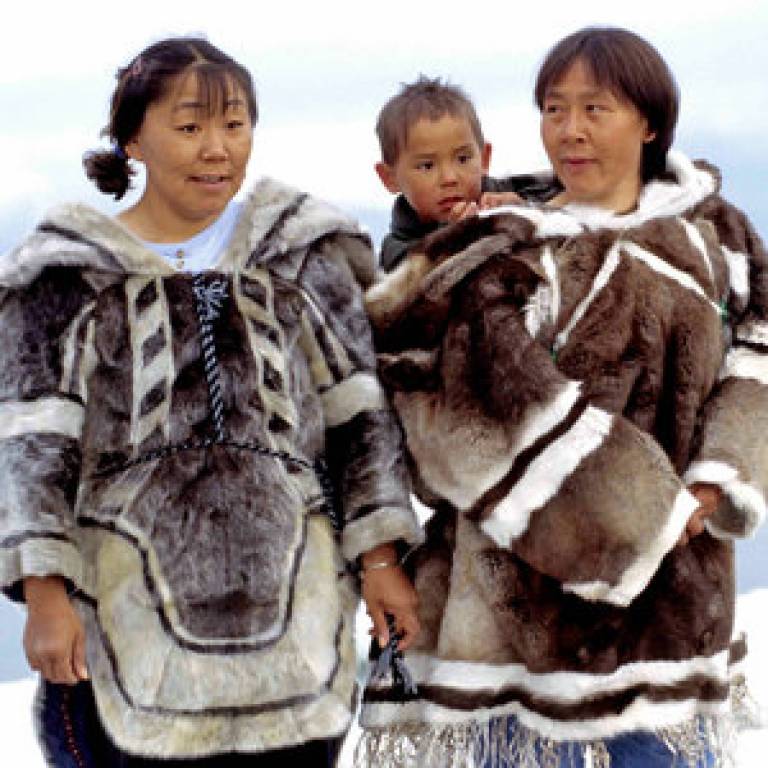How the Inuit adapted to Ice Age living and a high-fat diet
18 September 2015
Greenland natives - the Inuit - have mutations in genes that control how the body uses fat which provides the clearest evidence to date that human populations are adapted to particular diets according to new UCL research.
 The genetic
differences allow the Inuit to physically adapt to survive Arctic conditions
and live healthily on a traditional diet which is rich in omega-3
polyunsaturated fatty acids from marine mammal fat.
The genetic
differences allow the Inuit to physically adapt to survive Arctic conditions
and live healthily on a traditional diet which is rich in omega-3
polyunsaturated fatty acids from marine mammal fat.
The Inuit diet is an example of how high levels of omega-3 fatty acids can counterbalance the bad health effects of a high-fat diet. Fish oils were thought to be protective as the Inuit have a low incidence of cardiovascular disease, but having discovered their special genetic adaptations to this diet, the researchers from UCL, UC Berkeley and the University of Copenhagen say the benefits of the Inuit diet cannot be extrapolated to other populations.
Dr Pascale Gerbault (UCL Genetics, Evolution & Environment and UCL Anthropology), who co-authored the study, said: "These findings give us important clues about how our diet and the way we metabolise our food has affected and probably still affects our evolution. It suggests that our bodies differ in how they physically respond to diets depending on our genome, so what might be healthy for one person, isn't the case for another."
Published
today in the journal Science, the study shows that the genetic mutations
found in nearly 100 percent of the Inuit are seen in only 2 percent of
Europeans and 15 percent of Han Chinese, which means they would synthesize
omega-3 polyunsaturated fatty acids differently from the Inuit.
Co-first author of the study, Dr Matteo Fumagalli (UCL Genetics Institute), said: "The beneficial effects of these mutations seem to be at least 20,000 years old, and may have helped many groups of humans adapt to high-meat, high-fat, hunter-gatherer diets from large land and marine mammals rich in certain types of omega-3 and omega-6 fatty acids.
It's fascinating that Greenlanders have a unique genetic makeup that lets them better use their traditional food sources.
Dr Matteo Fumagalli
"We think it is a quite old selection that may have helped humans adapt to the
environment during the last Ice Age, but the selection is far stronger in the
Inuit than anywhere else. It's fascinating that Greenlanders have a unique
genetic makeup that lets them better use their traditional food sources," he
added.
The researchers found the genetic mutations in the Inuit have more widespread
effects. They lower "bad" cholesterol and fasting insulin levels, presumably
protecting against cardiovascular disease and diabetes. They also have a
significant effect on height, because growth is in part regulated by a person's
fatty acid profile, causing the Inuit's height to be reduced by two centimetres
on average.
The researchers analysed the genomes of 191 Greenlanders with less than 5
percent of European ancestry and compared them to the genomes of 60 Europeans
and 44 Han Chinese. They looked for mutations occurring in a large percentage
of Inuit individuals but in few or no other groups, which indicates that the
mutation spread throughout the Inuit because it was somehow useful to their
survival while not essential in other groups.
One cluster of mutations reduced the production of both omega-3 and omega-6 polyunsaturated fatty acids, which is thought to be in response to the high amount of these fatty acids coming from the Inuit diet. As changing the production of one fatty acid affects all fatty acids, it can cause knock-on effects including how growth hormones are regulated.
The researchers are now investigating the functional impact of other genetic differences in the Inuit to better understand the biological mechanisms that allow them to live on a high-fat diet at cold temperatures.
This study was co-lead by Dr Matteo Fumagalli at UCL, Dr Ida Moltke, Dr Anders Albrechtsen and Professor Torben Hansen at University of Copenhagen, and Professor Rasmus Nielsen at UC Berkeley. Funding was kindly provided by the Human Frontiers in Science Program Organization and a Leverhulme Programme Grant. Support was received by the National Institute for Health Research University College London Hospitals Biomedical Research Centre.
Links
- Research paper in Science
- Dr Matteo Fumagalli's academic profile on Iris
- Dr Pascale Gerbault's academic profile on Iris
- UCL Genetics Institute
- UCL Genetics, Evolution & Environment
- UCL Anthropology
Image
- Inuit (Credit: Ansgar Walk, Source: Wikimedia Commons)
Media contact
Bex Caygill
Tel: +44 (0)20 3108 3846
Email: r.caygill [at] ucl.ac.uk
 Close
Close

